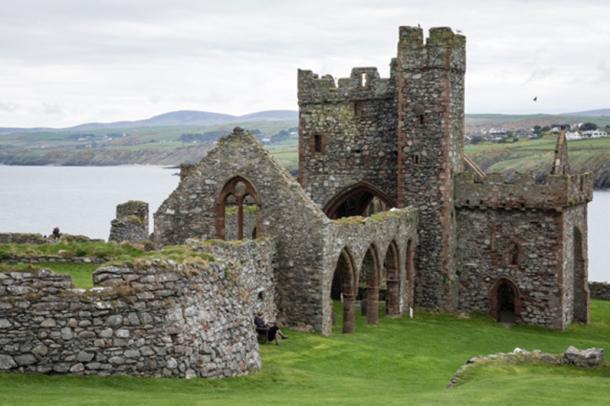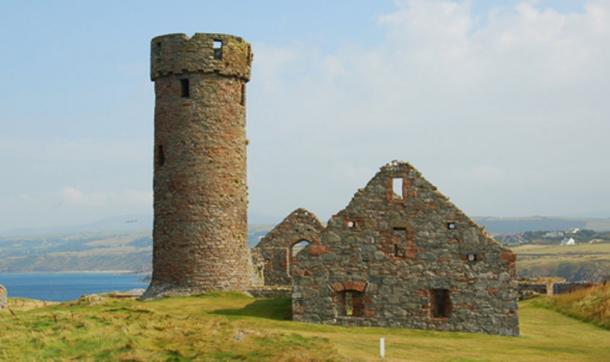Peel Castle: Centuries of History, a Mysterious Pagan Lady, and a Phantom Dog
The Isle of Man is a small island in the Irish Sea between Ireland and England and is a Crown Dependency of the United Kingdom. Because the island was settled approximately 8000 years ago, it has a long, diverse history and fascinating archaeological sites. A unique Celtic culture evolved alongside the local language, Manx, which is related to Gaelic Irish and Scottish. One of the most interesting sites on the Isle of Man is Peel Castle, which was built by the Vikings.
Centuries of Battles for the Isle of Man
In the 8th or 9th century, the Vikings landed on the island and controlled it for the next few centuries. They established a parliament on the island known as the Tynwald, possibly the oldest continuous parliament in the world. The Isle of Man later became part of the Kingdom of the Isles which included the Western Scottish Isles which was controlled by the King of Norway until the 13th century.
In 1254 it was ceded to the Scottish king. During the series of wars known as the Scottish Wars of Independence, the island alternated between Scottish and English control, but by the late 14th century the English controlled the island and they ruled through a series of local lords. Today, the island is largely self-governing and is a popular tourist location as well as a financial center.
- Manannan Mac Lir: God of the Sea and Guardian of the Afterlife
- Ring of Skulls: Ancient and Modern Sacrifices to the Water Gods
- Avalon: A Real Island Obscured by Legend, or Just a Legendary Island?

Peel Castle, Isle of Man. (Timelapsed / CC BY-NC 2.0)
Peel Castle and It’s Viking Origins
An Irish monastery was originally built on the site and it is widely held that its monks were the first to bring Christianity to the Isle of Man. The castle itself was built in the 11th century by Vikings from Norway on the orders of King Magnus Barefoot. He conquered the Kingdom of the Isles and the Norse city-state of Dublin and incorporated Peel into his realms, building the castle to secure his rule in the region. The castle was originally a wooden fort and the present stone castle was constructed over a period of centuries by the local Anglo-Norman lords.

Peel Castle as seen from the sea. (Ketteridge, B/ CC BY-NC 2.0)
After the end of the Scottish Wars of Independence, when the castle was no longer of any strategic importance, it was taken over by the Church, who built a cathedral within the walls of the old fortress. In the late 18th century, the cathedral was abandoned, and the castle has not been inhabited since, except of course for being haunted by a phantom dog.

The Pagan Lady’s necklace. (Manx National Heritage)
The castle was excavated in the 19th century and many important archaeological finds were made in the former stronghold. The most spellbinding was the grave of the Pagan Lady, as her role within the community is somewhat of a mystery.
The Remains of the Monastery and Castle
The castle is located on St Patrick’s Isle, named after the patron saint of Ireland and is linked to the town of Peel by a narrow causeway. The walls and buildings of the castle are built of local red sandstone. An extensive curtain wall encloses the site and there are several intact battlements. There is also a well-preserved flanking tower, guard house, and a gate house at the entrance. Part of the old round tower that was part of the Irish monastery is in the fortifications.
- Researchers Confirm Disputed Viking Warrior Was a Female Because Some Just Won’t Accept It
- Mighty Cartimandua, Queen of the Brigantes Tribe and Friend to Rome
- Marguerite de La Rocque: 16th Century Noblewoman Stranded on the Isle of Demons

Round Tower, Peel Castle. (Stringer, J/ CC BY-NC 2.0)
There are also some fine remains of a medieval battery and armory and a ‘garrison hall’ where soldiers lived. The original walls are still standing and the original gatehouse is still mostly intact.
There are many remains from the period when the castle was controlled by the Church. Although St Germain Cathedral is in ruins, it is still impressive and the walls are still standing. Many features of Romanesque architecture, as well as the cathedral’s crypt and old Reliquary of St Germain, can still be seen.
Visiting Peel Castle
Peel is on the west coast of the Isle of Man and is easy to get to from Douglas, the capital of the island. The only entrance to the site is by the causeway and there is an admission fee. Visitors are provided with audio headphones which will guide them along the site. It is possible to walk on the walls of the castle and they offer great views of the island and the Irish sea. There is plenty of accommodation near Peel Castle for those wishing to visit longer.
Top image: Peel Castle, Isle of Man. Source: vulcan57 / Adobe
By Ed Whelan
References
Hemer, K. A., Evans, J. A., Chenery, C. A., & Lamb, A. L. (2014). N o man is an island: Evidence of pre-Viking Age migration to the Isle of Man. Journal of Archaeological Science, 52, 242-249. Available at: https://www.sciencedirect.com/science/article/pii/S0305440314003185
Maddrell, A. (2016). Mapping changing shades of grief and consolation in the historic landscape of St. Patrick’s Isle, Isle of Man. Available at: https://www.taylorfrancis.com/books/e/9781317144649/chapters/10.4324/9781315579238-8
Quine, J. (2012). The Isle of Man. Cambridge University Press. Available at: https://books.google.ie/books?hl=en&lr=&id=p2Pr9zXw7xgC&oi=fnd&pg=PA1&dq=peel+castle+isle+of+man&ots=-QhWTIpSHG&sig=ttTM2bd-znfiikoB1PexVnB4e24&redir_esc=y#v=onepage&q=peel%20castle%20isle%20of%20man&f=false



















